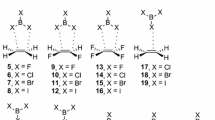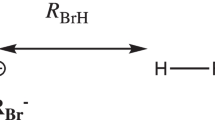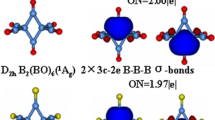Abstract
In this work the nature of the three-center two-electron (3c2e) chemical bonds in the diborane (6) molecule and the octahydrotriborate anion (B3H8−) is investigated by the Generalized Product Function Energy Partitioning (GPF-EP) method using modern valence bond wave functions. The Interference Energy Analysis shows that 3c2e bonds have the same features of a 2c2e bond: interference dominates the energetic balance for the formation of the bond and the kinetic energy drop is responsible for its stabilization. Also, 3c2e are generally way more energetic than a 2c2e analogous one, because interference can occur in three different ways (multiple interference effect), rather than just in one as for the two-center bonds. Furthermore, with the GPF-EP method one could establish a more rigorous way for discussing the idea of a “supported” bond in the diborane (6) molecule.









Similar content being viewed by others
Availability of data and material
The data sets generated during and/or analyzed during the current study are available from the corresponding author on reasonable request.
References
Ruedenberg K (1962) The physical nature of the chemical bond. Rev Mod Phys 34:326–376. https://doi.org/10.1103/RevModPhys.34.326
Cardozo TM, Nascimento MAC (2009) Energy partitioning for generalized product functions: the interference contribution to the energy of generalized valence bond and spin coupled wave functions. J Chem Phys 130:104102. https://doi.org/10.1063/1.3085953
Fantuzzi F, de Sousa DWO, Nascimento MAC (2017) The nature of the chemical bond from a quantum mechanical interference perspective. ChemistrySelect 2:604–619. https://doi.org/10.1002/slct.201601535
de Sousa DWO, Nascimento MAC (2017) Are one-electron bonds any different from standard two-electron covalent bonds? Acc Chem Res 50:2264–2272. https://doi.org/10.1021/acs.accounts.7b00260
Cardozo TM, Nascimento MAC (2009) Chemical bonding in the N2 molecule and the role of the quantum mechanical interference effect. J Phys Chem A 113:12541–12548. https://doi.org/10.1021/jp903963h
Cardozo TM, Nascimento Freitas G, Nascimento MAC (2010) Interference effect and the nature of the π-bonding in 1,3-butadiene. J Phys Chem A 114:8798–8805. https://doi.org/10.1021/jp101785p
Fantuzzi F, Cardozo TM, Nascimento MAC (2012) The role of quantum-mechanical interference and quasi-classical effects in conjugated hydrocarbons. Phys Chem Chem Phys 14:5479–5488. https://doi.org/10.1039/c2cp24125k
Vieira FS, Fantuzzi F, Cardozo TM, Nascimento MAC (2013) Interference energy in C–H and C–C bonds of saturated hydrocarbons: dependence on the type of chain and relationship to bond dissociation energy. J Phys Chem A 117:4025–4034. https://doi.org/10.1021/jp4005746
Cardozo TM, Fantuzzi F, Nascimento MAC (2014) The non-covalent nature of the molecular structure of the benzene molecule. Phys Chem Chem Phys 16:11024. https://doi.org/10.1039/c3cp55256j
Fantuzzi F, Nascimento MAC (2014) Description of polar chemical bonds from the quantum mechanical interference perspective. J Chem Theory Comput 10:2322–2332. https://doi.org/10.1021/ct500334f
Fantuzzi F, Cardozo TM, Nascimento MAC (2015) Nature of the chemical bond and origin of the inverted dipole moment in boron fluoride: a generalized valence bond approach. J Phys Chem A 119:5335–5343. https://doi.org/10.1021/jp510085r
de Sousa DWO, Nascimento MAC (2016) Is there a quadruple bond in C2? J Chem Theory Comput 12:2234–2241. https://doi.org/10.1021/acs.jctc.6b00055
Fantuzzi F, Cardozo TM, Nascimento MAC (2016) The nature of the singlet and triplet states of cyclobutadiene as revealed by quantum interference. ChemPhysChem 17:288–295. https://doi.org/10.1002/cphc.201500885
Fantuzzi F, Cardozo TM, Nascimento MAC (2017) On the metastability of doubly charged homonuclear diatomics. Phys Chem Chem Phys 19:19352–19359. https://doi.org/10.1039/C7CP02792C
Fantuzzi F, de Sousa DWO, Chaer Nascimento MA (2017) Chemical bonding in the pentagonal-pyramidal benzene dication and analogous isoelectronic hexa-coordinate species. Comput Theor Chem 1116:225–233. https://doi.org/10.1016/j.comptc.2017.03.020
de Sousa DWO, Nascimento MAC (2018) Quantum interference contribution to the dipole moment of diatomic molecules. J Phys Chem A 122:1406–1412. https://doi.org/10.1021/acs.jpca.7b11760
de Sousa DWO, Nascimento MAC (2019) One-electron bonds are not “half-bonds”. Phys Chem Chem Phys 21:13319–13336. https://doi.org/10.1039/C9CP02209K
Fantuzzi F, Wolff W, Quitián-Lara HM et al (2019) Unexpected reversal of stability in strained systems containing one-electron bonds. Phys Chem Chem Phys 21:24984–24992. https://doi.org/10.1039/C9CP04964A
Green JC, Green MLH, Parkin G (2012) The occurrence and representation of three-centre two-electron bonds in covalent inorganic compounds. Chem Commun 48:11481–11503. https://doi.org/10.1039/c2cc35304k
McMurry JE, Lectka T (1992) Three-center, two-electron C–H–C bonds in organic chemistry. Acc Chem Res 25:47–53. https://doi.org/10.1021/ar00013a007
Laszlo P (2000) A diborane story. Angew Chem Int Ed 39:2071–2072. https://doi.org/10.1002/1521-3773(20000616)39:12%3c2071:AID-ANIE2071%3e3.0.CO;2-C
Longuet-Higgins HC, Bell RP (1943) The structure of the boron hydrides. J Chem Soc. https://doi.org/10.1039/jr9430000250
Pitzer KS (1945) Electron deficient molecules. I. The principles of hydroboron structures. J Am Chem Soc 67:1126–1132. https://doi.org/10.1021/ja01223a026
Longuet-Higgins HG (1949) Substances hydrogénées avec défautd’électrons. J Chim Phys 46:268–275. https://doi.org/10.1051/jcp/1949460268
Hamilton WC (1956) A molecular orbital treatment of diborane as a four-centre, four-electron problem. Proc R Soc Lond Ser A Math Phys Sci 235:395–407. https://doi.org/10.1098/rspa.1956.0092
Mulliken RS (1947) The structure of diborane and related molecules. Chem Rev 41:207–217. https://doi.org/10.1021/cr60129a002
Rundle RE (1947) Electron deficient compounds. III. The bridge structure for B2H6. J Am Chem Soc 69:2075–2076. https://doi.org/10.1021/ja01200a522
Rundle RE (1949) Electron deficient compounds. II. Relative energies of ``half-bonds’’. J Chem Phys 17:671–675. https://doi.org/10.1063/1.1747367
Lipscomb WN (1954) Structures of the boron hydrides. J Chem Phys 22:985–988. https://doi.org/10.1063/1.1740319
Eberhardt WH, Crawford B, Lipscomb WN (1954) The valence structure of the boron hydrides. J Chem Phys 22:989–1001. https://doi.org/10.1063/1.1740320
Lipscomb WN (1977) The boranes and their relatives. Science (80-) 196:1047–1055. https://doi.org/10.1126/science.196.4294.1047
Mingos DMP (1972) A general theory for cluster and ring compounds of the main group and transition elements. Nat Phys Sci 236:99–102. https://doi.org/10.1038/physci236099a0
Hough WV, Edwards LJ, McElroy AD (1956) The sodium-diborane reaction. J Am Chem Soc 78:689–689. https://doi.org/10.1021/ja01584a047
Kodama G, Parry RW, Carter JC (1959) The preparation and properties of ammonia-triborane, H3NB3H7. J Am Chem Soc 81:3534–3538. https://doi.org/10.1021/ja01523a012
Peters CR, Nordman CE (1960) The structure of the B3H8− ion. J Am Chem Soc 82:5758. https://doi.org/10.1021/ja01506a053
Phillips WD, Miller HC, Muetterties EL (1959) B11 magnetic resonance study of boron compounds. J Am Chem Soc 81:4496–4500. https://doi.org/10.1021/ja01526a014
Lipscomb WN (1959) Structure and reactions of the boron hydrides. J Inorg Nucl Chem 11:1–8. https://doi.org/10.1016/0022-1902(59)80207-4
Pepperberg IM, Dixon DA, Lipscomb WN, Halgren TA (1978) The question of fluxional behavior in octahydrotriborate(1-) and pentaborane(11). Inorg Chem 17:587–593. https://doi.org/10.1021/ic50181a014
McKee ML, Lipscomb WN (1982) Ab initio study of the transient boron hydrides B3H7, B3H9, B4H8, and B4H12 and the fluxional anion B3H8−. Inorg Chem 21:2846–2850. https://doi.org/10.1021/ic00137a060
Duncan JL, Harper J (1984) The structure of the diborane molecule. Mol Phys 51:371–380. https://doi.org/10.1080/00268978400100251
Huang Z, King G, Chen X et al (2010) A simple and efficient way to synthesize unsolvated sodium octahydrotriborate. Inorg Chem 49:8185–8187. https://doi.org/10.1021/ic101543v
Dunbar AC, Macor JA, Girolami GS (2014) Synthesis and single crystal structure of sodium octahydrotriborate, NaB3H8. Inorg Chem 53:822–826. https://doi.org/10.1021/ic402127x
Longuet-Higgins HC (1957) The structures of electron-deficient molecules. Q Rev Chem Soc 11:121. https://doi.org/10.1039/qr9571100121
Hoffmann R, Lipscomb WN (1962) Boron hydrides: LCAO—MO and resonance studies. J Chem Phys 37:2872–2883. https://doi.org/10.1063/1.1733113
Duke BJ, Linnett JW (1966) Electronic structure of diborane and the diborohydride ion. Trans Faraday Soc 62:2955. https://doi.org/10.1039/tf9666202955
Gerratt J, Cooper DL, Karadakov PB, Raimondi M (1997) Modern valence bond theory. Chem Soc Rev 26:87. https://doi.org/10.1039/cs9972600087
Nascimento MAC, Barbosa AGH (2003) Quantum mechanics of many-electrons systems and the theories of chemical bond. In: Brändas EJ, Kryachko ES (eds) Fundamental world of quantum chemistry: a tribute to the memory of per-OlovLöwdin. Springer, Dordrecht, pp 371–406
Goddard WA (1967) Improved quantum theory of many-electron systems. I. Construction of eigenfunctions of S2 which satisfy Pauli’s principle. Phys Rev 157:73–80. https://doi.org/10.1103/PhysRev.157.73
Gerratt J, Lipscomb WN (1968) Spin-coupled wave functions for atoms and molecules. Proc Natl Acad Sci 59:332–335. https://doi.org/10.1073/pnas.59.2.332
Nascimento MAC (2019) The consequences of neglecting permutation symmetry in the description of many-electrons systems. Int J Quantum Chem 119:e25765. https://doi.org/10.1002/qua.25765
Wilson S, Gerratt J (1975) The electronic structure of the diborane molecule a self-consistent group function model. Mol Phys 30:765–775. https://doi.org/10.1080/00268977500102321
McWeeny R (1959) The density matrix in many-electron quantum mechanics. I. Generalized product functions. factorization and physical interpretation of the density matrices. Proc R Soc A Math Phys Eng Sci 253:242–259. https://doi.org/10.1098/rspa.1959.0191
Sironi M, Raimondi M, Cooper DL, Gerratt J (1991) Electronic structure of diborane and octahydrotriborate(1-): boron-hydrogen-boron bridges and closed boron-boron-boron bonds. J Phys Chem 95:10617–10623. https://doi.org/10.1021/j100179a024
DeKock RL, Bosma WB (1988) The three-center, two-electron chemical bond. J Chem Educ 65:194–197. https://doi.org/10.1021/ed065p194
Lipscomb WN (1973) Three-center bonds in electron-deficient compounds. The localized molecular orbital approach. Acc Chem Res 6:257–262. https://doi.org/10.1021/ar50068a001
Barbosa AGH, Henriques AM, Monteiro JGS et al (2018) The multiconfiguration spin-coupled approach for the description of the three-center two-electron chemical bond of some carbenium and nonclassical ions. Theor Chem Acc 137:21. https://doi.org/10.1007/s00214-017-2193-9
Karadakov PB, Cooper DL, Duke BJ, Li J (2012) Spin-coupled theory for ‘N electrons in M orbitals’ active spaces. J Phys Chem A 116:7238–7244. https://doi.org/10.1021/jp303998h
Ruščic B, Schwarz M, Berkowitz J (1989) Molecular structure and thermal stability of B2H4 and B2H4+ species. J Chem Phys 91:4576–4581. https://doi.org/10.1063/1.456745
Schmidt MW, Baldridge KK, Boatz JA et al (1993) General atomic and molecular electronic structure system. J Comput Chem 14:1347–1363. https://doi.org/10.1002/jcc.540141112
Li J, McWeeny R (2002) VB2000: pushing valence bond theory to new limits. Int J Quantum Chem 89:208–216. https://doi.org/10.1002/qua.10293
Barbosa AGH, Barcelos AM (2009) The electronic structure of the F2, Cl2, Br2 molecules: the description of charge-shift bonding within the generalized valence bond ansatz. Theor Chem Acc 122:51–66. https://doi.org/10.1007/s00214-008-0484-x
Kutzelnigg W, Schwarz WHE (1982) Formation of the chemical bond and orbital contraction. Phys Rev A 26:2361–2367. https://doi.org/10.1103/PhysRevA.26.2361
Cosby PC, Helm H (1988) Experimental determination of the H3+ bond dissociation energy. Chem Phys Lett 152:71–74. https://doi.org/10.1016/0009-2614(88)87330-5
Ruscic B, Feller D, Peterson KA (2014) Active Thermochemical Tables: dissociation energies of several homonuclear first-row diatomics and related thermochemical values. Theor Chem Acc 133:1415. https://doi.org/10.1007/s00214-013-1415-z
Korkin AA, Schleyer PVR, McKee ML (1995) Theoretical ab initio study of neutral and charged B3Hn (n = 3–9) species. importance of aromaticity in determining the structural preferences. Inorg Chem 34:961–977. https://doi.org/10.1021/ic00108a031
Acknowledgements
The authors acknowledge Conselho Nacional de Desenvolvimento Científico e Tecnológico (CNPq) (Grant No. 305656/2014-7), Fundação de Amparo à Pesquisa do Estado do Rio de Janeiro (FAPERJ) (Grant No. E-26/202.939/2017) for financial support, and Coordenação de Aperfeiçoamento de Pessoal de Nível Superior (CAPES) (Grant No. Finance Code 001) for the PhD scholarship.
Funding
This study was financed in part by Coordenação de Aperfeiçoamento de Pessoal de Nível Superior—Brasil (CAPES)—Finance Code 001.
Author information
Authors and Affiliations
Corresponding author
Ethics declarations
Conflict of interest
The authors declare that they have no conflict of interest.
Additional information
Publisher's Note
Springer Nature remains neutral with regard to jurisdictional claims in published maps and institutional affiliations.
“Festschrift in honor of Prof. Fernando R. Ornellas” Guest Edited by Adélia Justino Aguiar Aquino, Antonio Gustavo Sampaio de Oliveira Filho & Francisco Bolivar Correto Machado.
Rights and permissions
About this article
Cite this article
de Sousa, D.W.O., Nascimento, M.A.C. Three-center two-electron bonds in the boranes B2H6 and B3H8− from the quantum interference perspective. Theor Chem Acc 139, 140 (2020). https://doi.org/10.1007/s00214-020-02654-4
Received:
Accepted:
Published:
DOI: https://doi.org/10.1007/s00214-020-02654-4




